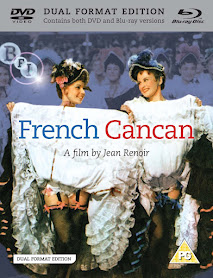French Cancan; musical comedy-drama, France / Italy, 1955, D: Jean Renoir, S: Jean Gabin, Françoise Arnoul, María Félix, Anna Amendola, Jean-Roger Caussimon, Philippe Clay
Paris towards the end of the 19th century. Henri Danglard owns a night club that entertains the male audience with belly dancer Lola, who is also his lover. However, he owes a lot of money, and the shows are not going that well lately. One night, Danglard spots a girl, Nini, dancing French can-can, a dance from the 1840s, with her lover Paulo in a tavern, and is fascinated by her. The next day, Danglard persuades Nini to join his troupe so that he could organize a new night club, the Moulin Rouge, featuring can-can. Nini accepts money to finance the Moulin Rouge from Prince Alexander, but becomes Danglard’s lover, angering Paulo, and causing Alexander to try to shoot himself from a broken heart. Upon finding out Danglard found a new, younger lover, Esther, Nini refuses to dance on the opening night of the Moulin Rouge, but is finally persuaded to go out and dance with a dozen other women, because art is more important than personal problems. The premiere is a success.
Included in Roger Ebert’s Great Movies list, “French Cancan” is an unusual turn in director Jean Renoir’s career, who surprised the critics with this departure from ambitious dramas to go on an excursion into a light, optimistic musical-comedy that celebrates life. At times it is indeed fresh and effervescent, depicting the origins of Moulin Rouge, yet at other times it feels stiff and dusty. Renoir uses the often trope of an artist in crisis who accidentally meets someone who inspires him of his greatest achievement—in this case, protagonist Danglard who is fascinated when he sees a girl, Nini, dancing the French can-can in a tavern with her boyfriend Paulo, and thus decides to put this dance on his regular schedule to attract an audience. Francoise Arnoul is simply fantastic as Nini, conveying both innocence and wild energy during dancing, establishing herself as the undisputed highlight of the film. Renoir uses all these dance trainings as an excuse to dwell on women’s bodies and their sensual lifting up of skirts, but when the result is this cheerful, then so be it.
Renoir’s style is too conventional and ordinary, yet some of his details are poignant: in one, he shows the trials and tribulations of a performer’s life in the scene where Paulo threatens to cut all ties with Nini if she performs the can-can in front of a mass audience, since he considers it too intimate. In another, there is a codified “running gag” of Nini witnessing Danglard constantly meeting an old lady on the street and buying flowers from her, again and again, implying she was his former mistress, until this comes full circle when Nini spots Danglard kissing a younger girl backstage, causing Nini to revolt against his constant dumping of old lovers for younger ones. Not every scene is interesting, but there are some nice bits of trivial details that illustrate the feel of these artists living at that certain time and place—including a sequence where one of Danglard’s assistants brings croissants for the bankrupt troupe in the room, since she works in a cafeteria, and Danglard, in his pajamas, really cherishes this delicious meal for breakfast. The finale takes a long time, but offers a great dance of a dozen women doing the can-can, including Nini pulling up her skirt completely, leaning forward and showing her underwear to the audience. A surprisingly uplifting and relaxed film from the director, with enough good parts to cover up for the overstretched ones.
Grade:+++






No comments:
Post a Comment